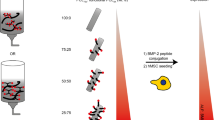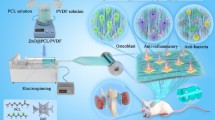Abstract
Biodegradable materials, in particular poly(L-lactic acid), are widely used in medicine and tissue engineering. Electrospinning is one of the most promising methods for the fabrication of scaffolds for tissue and organ regeneration. Due to their fibrous structure, high surface-to-volume ratio and great adjustability of electrospinning parameters such scaffolds are able to mimic the topology of the extracellular matrix (ECM) of a native human tissue. This paper demonstrates the effect of radio frequency magnetron sputtering (RFMS) modification of the poly(L-lactic acid) fibrous scaffolds on their structure and cell adhesion and proliferation. RFMS modification was performed using four different targets: hydroxyapatite (HAP), tricalcium phosphate (TCP), amorphous calcium pyrophosphate (CPP) and dicalcium phosphate dihydrate (DCPD). Biodegradable fibrous materials with maximum Ca/P ratio on the surface at 0.542 were obtained. It was observed that prolonged time of the treatment leads to destruction of the fibers on the surface layer of the scaffold. Moreover, we have indicated that all obtained materials demonstrate cytotoxic activity due to the formation of the toxic compounds on the material surface.



Similar content being viewed by others
References
Barnes, C. P., Sell, S. A., Boland, E. D., Simpson, D. G., & Bowlin, G. L. (2007). Nanofiber technology: designing the next generation of tissue engineering scaffolds. Advanced Drug Delivery Reviews, 59(14), 1413–1433. doi:10.1016/j.addr.2007.04.022.
Agarwal, S., Wendorff, J. H., & Greiner, A. (2008). Use of electrospinning technique for biomedical applications. Polymer, 49(26), 5603–5621. doi:10.1016/j.polymer.2008.09.014.
Agarwal, S. (2012). Biodegradable polyesters. In Polymer Science: A Comprehensive Reference (pp. 333–361). Elsevier. doi:10.1016/B978-0-444-53349-4.00145-X
Rasal, R. M., Janorkar, A. V., & Hirt, D. E. (2010). Poly(lactic acid) modifications. Progress in Polymer Science (Oxford), 35(3), 338–356. doi:10.1016/j.progpolymsci.2009.12.003.
Tian, H., Tang, Z., Zhuang, X., Chen, X., & Jing, X. (2012). Biodegradable synthetic polymers: preparation, functionalization and biomedical application. Progress in Polymer Science, 37(2), 237–280. doi:10.1016/j.progpolymsci.2011.06.004.
Urquia Edreira, E. R., Wolke, J. G. C., te Riet, J., Kotnur, G. V., Janssen, G. C. A. M., Jansen, J. A., & van den Beucken, J. J. J. P. (2015). Residual stress evaluation within hydroxyapatite coatings of different micrometer thicknesses. Surface and Coating Technology, 266, 177–182. doi:10.1016/j.surfcoat.2015.02.040.
Sánchez-Hernández, Z. E., Domínguez-Crespo, M. A., Torres-Huerta, A. M., Onofre-Bustamante, E., Andraca Adame, J., & Dorantes-Rosales, H. (2014). Improvement of adhesion and barrier properties of biomedical stainless steel by deposition of YSZ coatings using RF magnetron sputtering. Materials Characterization, 91, 50–57. doi:10.1016/j.matchar.2014.02.007.
Fernández, S., Santos, J. D., Munuera, C., García-Hernández, M., & Naranjo, F. B. (2015). Effect of argon plasma-treated polyethylene terepthalate on ZnO:Al properties for flexible thin film silicon solar cells applications. Solar Energy Materials & Solar Cells, 133, 170–179. doi:10.1016/j.solmat.2014.10.030.
Barradas, A. M. C., Yuan, H., van Blitterswijk, C. A., & Habibovic, P. (2011). Osteoinductive biomaterials: current knowledge of properties, experimental models and biological mechanisms. European Cells & Materials, 21, 407–429.
Fujishiro, Y., Hench, L. L., & Oonishi, H. (1997). Quantitative rates of in vivo bone generation for Bioglass® and hydroxyapatite particles as bone graft substitute. Journal of Materials Science. Materials in Medicine, 8(11), 649–652. doi:10.1023/A:1018527621356.
Rodriguez, I. A., Mccool, J. M., & Bowlin, G. L. (2012). Functional nanofibers for tissue engineering applications. Functional Nanofibers and their Applications. Woodhead Publishing Limited. doi:10.1016/B978-0-85709-069-0.50009-4
Tverdokhlebov, S. I., Bolbasov, E. N., Shesterikov, E. V., Antonova, L. V., Golovkin, A. S., Matveeva, V. G., et al. (2015). Modification of polylactic acid surface using RF plasma discharge with sputter deposition of a hydroxyapatite target for increased biocompatibility. Applied Surface Science, 329, 32–39. doi:10.1016/j.apsusc.2014.12.127.
Tverdokhlebov, S. I., Bolbasov, E. N., Shesterikov, E. V., Malchikhina, A. I., Novikov, V. A., & Anissimov, Y. G. (2012). Research of the surface properties of the thermoplastic copolymer of vinilidene fluoride and tetrafluoroethylene modified with radio-frequency magnetron sputtering for medical application. Applied Surface Science, 263, 187–194. doi:10.1016/j.apsusc.2012.09.025.
Ozeki, K., Fukui, Y., & Aoki, H. (2007). Influence of the calcium phosphate content of the target on the phase composition and deposition rate of sputtered films. Applied Surface Science, 253(11), 5040–5044. doi:10.1016/j.apsusc.2006.11.011.
Schneider, C. A., Rasband, W. S., & Eliceiri, K. W. (2012). NIH Image to ImageJ: 25 years of image analysis. Nature Methods, 9(7), 671–675. doi:10.1038/nmeth.2089.
Dmitrieva, R. I., Minullina, I. R., Bilibina, A. A., Tarasova, O. V., Anisimov, S. V., & Zaritskey, A. Y. (2012). Bone marrow- and subcutaneous adipose tissue-derived mesenchymal stem cells: differences and similarities. Cell Cycle, 11(2), 377–383. doi:10.4161/cc.11.2.18858.
López, E. O., Mello, A., Sendão, H., Costa, L. T., Rossi, A. L., Ospina, R. O., et al. (2013). Growth of crystalline hydroxyapatite thin films at room temperature by tuning the energy of the RF-magnetron sputtering plasma. ACS Applied Materials & Interfaces, 5(19), 9435–9445. doi:10.1021/am4020007.
Boyd, A. R., O’Kane, C., & Meenan, B. J. (2013). Control of calcium phosphate thin film stoichiometry using multi-target sputter deposition. Surface and Coating Technology, 233, 131–139. doi:10.1016/j.surfcoat.2013.04.017.
López, E. O., Mello, A., Farina, M., Rossi, A. M., & Rossi, A. L. (2015). Nanoscale analysis of calcium phosphate films obtained by RF magnetron sputtering during the initial stages of deposition. Surface and Coating Technology, 279, 16–24. doi:10.1016/j.surfcoat.2015.08.021.
Zaichick, V., & Tzaphlidou, M. (2003). Calcium and phosphorus concentrations and the calcium/phosphorus ratio in trabecular bone from the femoral neck of healthy humans as determined by neutron activation analysis. Applied Radiation and Isotopes, 58(6), 623–627. doi:10.1016/S0969-8043(03)00092-7.
Prabhakaran, M. P., Venugopal, J., & Ramakrishna, S. (2009). Electrospun nanostructured scaffolds for bone tissue engineering. Acta Biomaterialia, 5(8), 2884–2893. doi:10.1016/j.actbio.2009.05.007.
He, C., Jin, X., & Ma, P. X. (2014). Calcium phosphate deposition rate, structure and osteoconductivity on electrospun poly(l-lactic acid) matrix using electrodeposition or simulated body fluid incubation. Acta Biomaterialia, 10(1), 419–427. doi:10.1016/j.actbio.2013.08.041.
N\olte, A. J., Treat, N. D., Cohen, R. E., & Rubner, M. F. (2008). Effect of relative humidity on the Young’s modulus of polyelectrolyte multilayer films and related nonionic polymers. Macromolecules, 41(15), 5793–5798. doi:10.1021/ma800732j.
Gai, M., Frueh, J., Kudryavtseva, V. L., Mao, R., Kiryukhin, M. V., & Sukhorukov, G. B. (2016). Patterned microstructure fabrication: polyelectrolyte complexes vs polyelectrolyte multilayers. Scientific Reports, 6, 37000. doi:10.1038/srep37000.
Hossfeld, S., Nolte, A., Hartmann, H., Recke, M., Schaller, M., Walker, T., et al. (2013). Bioactive coronary stent coating based on layer-by-layer technology for siRNA release. Acta Biomaterialia, 9(5), 6741–6752. doi:10.1016/j.actbio.2013.01.013.
Hartmann, H., Hossfeld, S., Schlosshauer, B., Mittnacht, U., Pêgo, A. P., Dauner, M., et al. (2013). Hyaluronic acid/chitosan multilayer coatings on neuronal implants for localized delivery of siRNA nanoplexes. Journal of Controlled Release, 168(3), 289–297. doi:10.1016/j.jconrel.2013.03.026.
Valverde, T. M., Castro, E. G., Cardoso, M. H. S., Martins-Júnior, P. A., Souza, L. M. O., Silva, P. P., et al. (2016). A novel 3D bone-mimetic scaffold composed of collagen/MTA/MWCNT modulates cell migration and osteogenesis. Life Sciences, 162, 115–124. doi:10.1016/j.lfs.2016.08.003.
Acknowledgements
This research was funded by the Russian Science Foundation (project no. 16-13-10239) and performed in Tomsk Polytechnic University.
Author information
Authors and Affiliations
Corresponding author
Rights and permissions
About this article
Cite this article
Goreninskii, S.I., Bogomolova, N.N., Malchikhina, A.I. et al. Biological Effect of the Surface Modification of the Fibrous Poly(L-lactic acid) Scaffolds by Radio Frequency Magnetron Sputtering of Different Calcium-Phosphate Targets. BioNanoSci. 7, 50–57 (2017). https://doi.org/10.1007/s12668-016-0383-x
Published:
Issue Date:
DOI: https://doi.org/10.1007/s12668-016-0383-x




